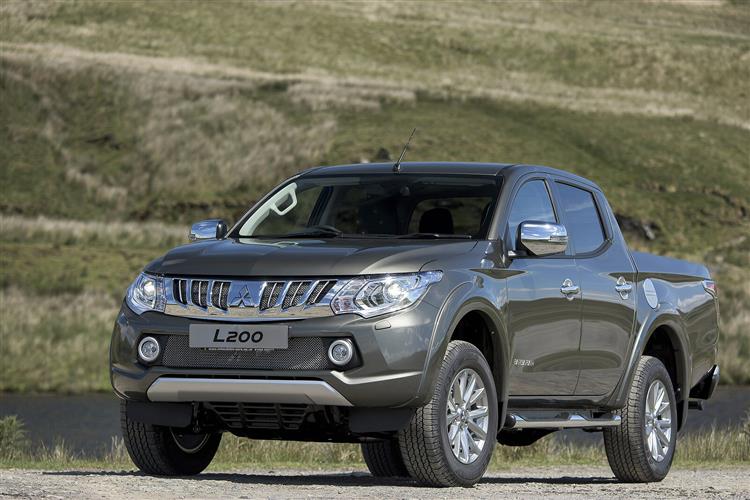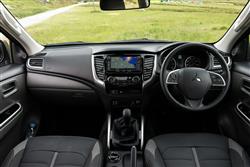How will you view?
This is a sample, showing 30 seconds of each section.
ONE L OF A TRUCK? (some text hidden) SECTIONED_new_mitsubishil200series5_2015
By Jonathan Crouch
Introductionword count: 80
Mitsubishi went to town with this fifth generation L200 pick-up, completely redesigning the engine, the suspension, the steering and the transmission - and that was just the start. Compared to the previous Series 4 model, it was more aerodynamic, better equipped, nicer to sit in and much more efficient. Plus it remained great off road and, if you tow, this vehicle will lug more about than any other rival from this era can. You can see why buyers like it.
Modelsword count: 12
2DR/4DR PICK-UP - 2.4 DI-D DIESEL (SINGLE CAB, CLUB CAB, DOUBLE CAB)
Historyword count: 324
Globally, Mitsubishi has six decades of pick-up production experience and by the time of the launch of this Series 5 L200 model, had sold well over four million of them, mostly L200s, a model range first launched way back in 1982. It was the 'Series 3' third generation version we first saw in 1996 though, that really hit the big time for this Japanese brand, a model since credited with the rejuvenation of this entire market segment. It was the first to recognise that the pick-up needn't be merely a utilitarian workhorse fit only for farmers and jobbing builders. The MK3 model L200 could be dressed up to look and feel more like a lifestyle SUV - and a very cost-effective one at that. Tax loopholes just after the turn of the century not only allowed businesses to reclaim VAT on the purchase price but also enabled company car users to pay a flat tax rate that gave them big savings and Mitsubishi found itself with the one vehicle in the sector that could take full advantage. Customers flocked to the company's showrooms and at one point, the brand was taking 70% of sales in this class. After that though, things changed a little. The tax laws tightened - and the competition upped its game - but fortunately for Mitsubishi, pick-up buyers tend to like to stick to what they know, with the result that the Series 4 L200 model, launched in 2006 and updated in 2010, still led sales in the segment by a healthy margin for most of its lifetime. By 2015 though, another step forward was needed, hence the effort that was put into making sure that this Series 5 model would provide it, with significant improvements in over 330 areas. It was, we were told at launch, once again number one for a reason. This fifth generation L200 sold until mid-2019, when it was replaced by the Series 6 model.
What You Getword count: 409
As before, single cab, Club cab and double cab body styles were offered. Most went for the double cab. At first glance, this fifth generation L200 double cab pick-up seems little more than an evolution of its successful Series 4 predecessor. Look a little closer though and you discover that it's actually more than 80% new, only three sections of floor and the main chassis rails having been carried over from before. And inside? Well at first glance, those familiar with previous generation L200 models might not feel that very much has changed but once you start to look around, key improvements begin to become apparent. Primarily, it's all a bit more car-like, with less of the feel that other pick-ups give you of being sat in a commercial vehicle. To that end, the dash has more depth in Series 5 models and though it's still trimmed in hard-wearing plastic, the material seems of reasonable quality and is enhanced on plusher models by splashes of silver and piano black trim. The design of the fascia is more like an SUV than an LCV too, with a smart high-mounted touchscreen on the two top models that includes navigation and an incorporated rear view camera display. In the back, the main change over the previous Series 4 model is that the total cabin zone of this vehicle is bigger, the 1,745mm total length making it 56mm longer than a rival Toyota Hilux of this era and a massive 103mm longer than a Volkswagen Amarok. That isn't something you especially notice at the front but it makes a big difference at the rear when it comes to legroom, especially of course on longer trips. What about load area practicalities. At the business end, you're faced with a cargo bed 475mm deep - that's 15mm deeper than the previous Series 4 model - and 1,470mm in both length and width. In this area, you'd be able to take a payload of up to 1,045kg. Most rivals can better these figures but that, according to Mitsubishi, doesn't tell the whole story. The brand points out that the stat that really matters to many operators is the one for combined carrying and towing capacity, an area in which this Series 5 L200 is indisputably a class leader from this era. Combine the cargo area capacity with this model's prodigious braked towing capability of up to 3,100kg and you'll be able to lug up to 4,090kg.
To see the full road test text contact us on 0330 0020 227
Pictures (high res disabled)

.jpg)
|
.jpg)
|
.jpg)
| |||
.jpg)
|
.jpg)
|
.jpg)
| |||
.jpg)
|

|
Scoring (subset of scores)
Category: Pick-Ups
| Performance | |
| Handling | |
| Comfort | |
| Space | |
| Styling, Build, Value, Equipment, Depreciation, Handling, Insurance and Total scores are available with our full data feed. | |



